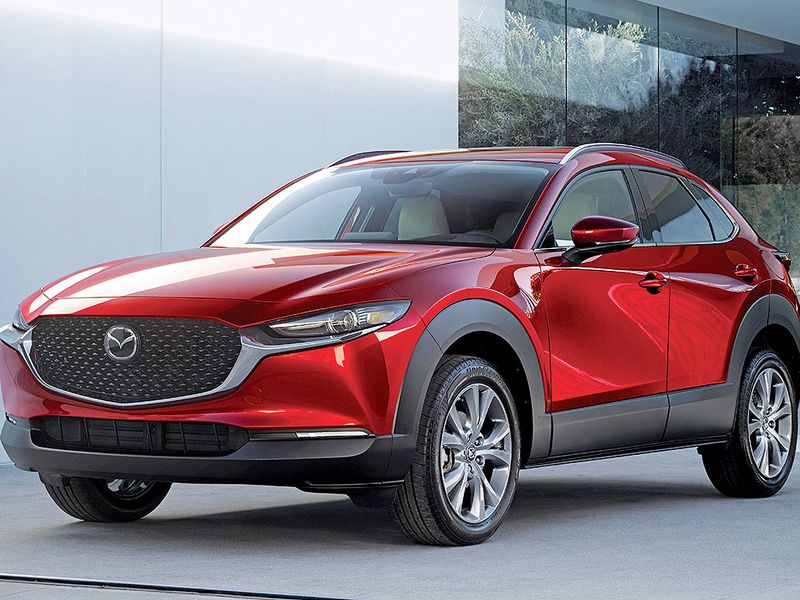
Editor’s note: This story is part of the annual Automotive News “Future Product Pipeline” series.
Mazda’s addition of the CX-30 crossover this year has paid off big for U.S. sales, allowing the Japanese automaker to weather the coronavirus crisis better than its bigger rivals.
As it awaits another new crossover next year — from its Alabama joint- venture with Toyota — Mazda is adding new powertrain options to keep its lineup lively.
They include both a down-market motor that lowers the price of the base Mazda3 sedan, and an upmarket turbocharged engine for the Mazda3 sedan and hatch that advances the brand’s premium intentions. The top trim hatchback with turbo and all-wheel drive starts at $34,696 with shipping.
The turbo motor will show up in the CX-30 as well, making for a potent subcompact CUV. The smaller nonturbo motor could also be a future option for the base model.
What isn’t offered are hybrid, plug-in hybrid or EV options. Mazda will roll out its new MX-30 hybrid and EV for other markets but not the U.S. But it expects to eventually add hybrid powertrains in North America.
The automaker is also expected to continue adding to its stable of gasoline engines, with a new inline six-cylinder motor being developed for a new rear-wheel-drive platform that could debut on the Mazda6 sedan in two or three years. That platform would also help with the brand’s shift upmarket to near-luxury status.
Mazda3: The base sedan for 2021 will be fitted with a smaller engine that lowers the price by $1,000 to $21,445 with shipping. Mazda’s president of North American Operations, Jeff Guyton, has said the Mazda3’s launch at the higher price point helped margins but hurt volume. Meanwhile, a new turbocharged engine option will push the priciest Mazda3 hatchback turbo with awd to $34,696 with shipping. The sedan and hatch should be freshened in 2021 and redesigned in 2024.
Mazda6: The third-generation sedan was freshened in 2018 and is due for a redesign, but Mazda may have a bigger plan. With sales for the front-wheel-drive midsize cratering and the automaker eager to move upmarket, the next update may move it to rear-wheel drive with a new inline six-cylinder engine to replace its current four-cylinder. The Vision concept from 2017 may provide some styling cues. Mazda has confirmed a new platform and new engine, but not the vehicles that will use them. The redesigned sedan could come in 2022. For the 2021 model year, the sedan will see a Carbon Edition with gray paint and red leather seats.
MX-5 Miata: The current two-door sports car was given a power boost for the 2019 model year and carries over into the 2021 model year with one notable exception. This fall a special edition will be offered in both the soft-top convertible model and the RF retractable fastback hard top to mark Mazda’s 100th anniversary as a company in January. The centennial Miata will come in white with red accents and anniversary badges.
CX-3: Mazda is sticking with the CX-3 subcompact crossover for now, even though the new CX-30 is essentially in the same size class. The 2021 CX-3 comes in one trim, starting at $21,740 with shipping. Awd adds $1,400. A redesign could come in 2022 — if Mazda decides to keep it in the U.S.
CX-30: The subcompact crossover, which shares a platform with the Mazda3 sedan and hatchback, was new for 2020 and has turned out to be a major hit. Mazda priced the CUV at $23,000 with shipping to start, with a strong four-cylinder engine making 186 hp. For 2021, Apple CarPlay and Android Auto are standard. With Mazda stressing powertrain choices and a range of price points for its 2021 models, the CX-30 could get both the down-market engine from the 2021 Mazda3 sedan and the upmarket turbocharged motor available on the higher trims of the sedan and hatchback. A freshen should come in 2023.
CX-5: The automaker’s bestselling model receives a new standard 10.25-inch infotainment screen and a limited Carbon Edition trim for the 2021 model year. A redesign should come in 2022. Mazda may change the name to the CX-50 after breaking its one-digit naming convention for the CX-30.
CX-7: Mazda hasn’t said much about the new crossover that will come out of a joint-venture factory with Toyota in Alabama sometime next year. Mazda has said it will be an entirely separate model from what Toyota will make there. But Mazda has hinted that it has a fairly obvious gap in its lineup between the compact CX-5 and the three-row CX-9. Mazda has also previously used the CX-7 name, making it a logical move. It could also be the CX-70 if Mazda decides to add a zero to its crossover names. The new crossover is likely to offer Mazda’s first hybrid platform in the U.S. Mazda and Toyota have said the distinct U.S.-built vehicles could share some parts, and Toyota is sure to make a hybrid version of its upcoming crossover there.
CX-9: For 2021, the model mostly carries over but gets a new standard 10.25-inch infotainment screen and a Carbon Edition with gray paint, red leather seats and other small details. The three-row crossover is ready for a redesign, which could come in 2021 or 2022. Since Mazda is developing a six-cylinder engine and likely a rwd architecture for the new motor, a future CX-9 could move to that platform as a more premium vehicle to fit Mazda’s new image.
EV: Mazda will sell its first electric vehicle in Europe, the MX-30, which is available for pre-order. It’s also planning a hybrid version of the subcompact crossover. The MX-30 could come to the U.S. in the future. But Mazda has only said that it will announce new markets closer to the launch date in those markets.